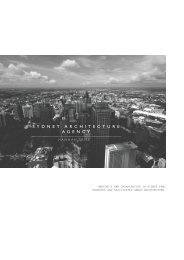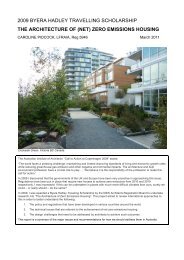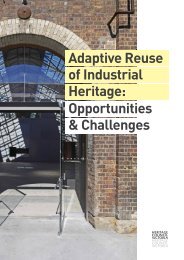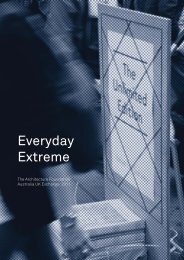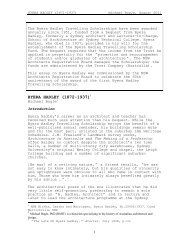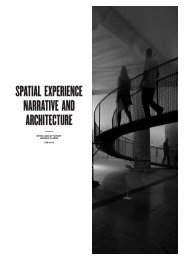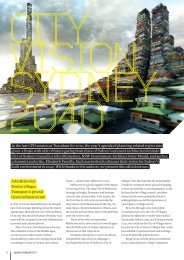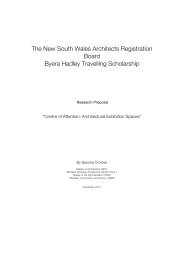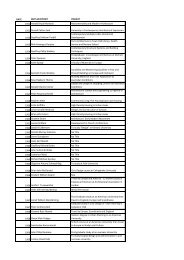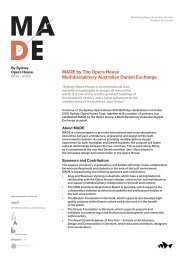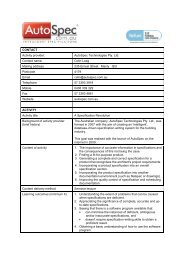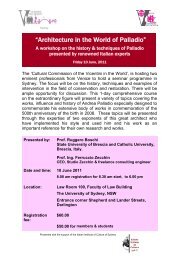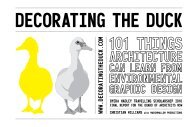4 unités LC - Architecture Insights
4 unités LC - Architecture Insights
4 unités LC - Architecture Insights
You also want an ePaper? Increase the reach of your titles
YUMPU automatically turns print PDFs into web optimized ePapers that Google loves.
1 Le Corbusier, The Marseilles Block, trans. Geoffrey Sainsbury, The Harvill<br />
Press, London, 1953, p. 45.<br />
2 Extract taken from the translation of the address Le Corbusier gave to M.<br />
Claudius Petit, Minister of Reconstruction and Urbanism at the time, upon<br />
the handing over of the ‘Unité d’habitation’ of Marseilles in 1952.<br />
Boesiger, W., Le Corbusier et Pierre Jeanneret: Œuvre Complète 1946 –<br />
1952, Volume 5, (text by Le Corbusier), Les Editions d’<strong>Architecture</strong>s, Zurich,<br />
1946, p. 191.<br />
3 Le Corbusier himself actually states that he had spent “forty-three years of<br />
experiment” leading up to the construction of the ‘Unité’ in Marseille (Le<br />
Corbusier, The Marseilles Block, trans. Geoffrey Sainsbury, The Harvill Press,<br />
London, 1953, p. 45), giving this period of time as 1907-1950. This,<br />
however, is the period of time he himself spent considering the ideas leading<br />
up to the ‘Unité’, whereas his first publicly presented works were not the<br />
1920s, with La Maison Citrohan (1919) and Une Ville Contemporaine<br />
(1922).<br />
4 Le Corbusier provides his own version of such a history leading up to the<br />
first constructed ‘Unité d’habitation’ in The Marseilles Block, trans. Geoffrey<br />
Sainsbury, The Harvill Press, London, 1953, p. 45, entitling his list of events,<br />
projects, writings and revelations: The Long Trek 1907-1950. But this too<br />
misses out on many of the projects and influences that other writers have<br />
since noted, such as in Besset, Maurice, Qui était Le Corbusier?, Editions<br />
d’Art Albert Skira, Geneva, Switzerland, 1968; Von Moos, Stanislaus, Le<br />
Corbusier, Elements of a Synthesis, The MIT Press, Cambridge,<br />
Massachusetts, 2nd Ed., 1980; Evenson, Norma, Le Corbusier: The Machine<br />
and The Grand Design, George Braziller, New York, 1969; essays such as<br />
Scully, Vincent, Le Corbusier, 1922-1965, Tafuri, Manfredo,“Machine et<br />
mémoire”: The City in the Work of Le Corbusier, Von Moos, Stanislaus,<br />
Urbanism and Transcultural Exchanges, 1910-1935: A survey, Evenson,<br />
Norma, Yesterday’s City of Tomorrow Today, all compiled in Brooks, H. Allen<br />
(Ed.), Le Corbusier, Princeton University Press, New Jersey, 1987; also<br />
Benton, Tim, Urbanism, published in the exhibition catalogue, Le Corbusier<br />
Architect of the Century, Arts Council of Great Britain, London, 1987; and<br />
Frampton, Kenneth, The Rise and Fall of the Radiant City: Le Corbusier<br />
1928-1960, published in Oppositions (A Journal for Ideas and Criticism in<br />
<strong>Architecture</strong>), Winter/Spring 1980: 19/20, MIT Press, USA.<br />
47 48<br />
5 Le Corbusier displayed this interest in Sitte in an early essay written in 1910<br />
entitled La Construction des Villes. Although he later criticised Sitte for his<br />
pitturesque style, comparing it to the path of a donkey that “zigzags and<br />
dawdles, absent-mindedly” (Le Corbusier,Urbanisme, 1925), he was originally<br />
impressed, however, by Sitte’s approach to a city as a whole architectural<br />
landscape and his perceptive analyses of historic cities. See Besset, Maurice,<br />
Qui était Le Corbusier?, Editions d’Art Albert Skira, Geneva, Switzerland,<br />
1968, p. 151; and Benton, Tim, Urbanism, Chapter 4 of exhibition<br />
catalogue, Le Corbusier Architect of the Century, Arts Council of Great<br />
Britain, London, 1987, pp. 200-201.<br />
6 Although Le Corbusier strongly disapproved of the ‘de-urbanisation’<br />
represented in the ‘garden-cities’, he was, however, inspired by the ‘essential<br />
joys’ that Howard promoted through sunlight, open space and greenery. Le<br />
Corbusier’s solution that used these ideas of integrated housing with parks and<br />
gardens avoided problems of isolation in the horizontal sprawl of the ‘garden<br />
cities’ by introducing the vertical ‘garden city’. See Besset, Maurice, Qui était<br />
Le Corbusier?, Editions d’Art Albert Skira, Geneva, Switzerland, 1968, p.<br />
152; and Benton, Tim, Urbanism, Chapter 4 of exhibition catalogue, Le<br />
Corbusier Architect of the Century, Arts Council of Great Britain, London,<br />
1987, pp. 200-201.<br />
7 Le Corbusier was born in Switzerland, in the small town of La Chaux-de-<br />
Fonds in the Swiss Jura. Although he traveled and worked briefly in Vienna,<br />
Paris and Berlin during his years of study, he did not in fact settle in Paris<br />
until 1917, at the age of thirty. (Jenger, Jean, Le Corbusier: L’<strong>Architecture</strong><br />
pour Emouvior, Gallimard, Evreux, 1993, p. 33)<br />
8 L’Esprit Nouveau (meaning ‘The New Mind’) was a review founded by Le<br />
Corbusier himself, along with the painter Amédée Ozenfant and poet Paul<br />
Dermée. Twenty-eight issues of the review were published between 1920 and<br />
1925. (Jenger, Jean, Le Corbusier: L’<strong>Architecture</strong> pour Emouvior, Gallimard,<br />
Evreux, 1993, p. 41)<br />
9 Boesiger, W. + Stonorov, O., Le Corbusier et Pierre Jeanneret: Œuvre<br />
Complète 1910 – 1929, Volume 1 of l’Œuvre Complète, (text by Le<br />
Corbusier), Girsberger, Zurich, 2nd Ed., 1974, pp. 34-39.<br />
10 The twenty-two storey Tacoma building in Chicago by Holabird and Roche<br />
had been built in 1887-88 following the development of the steel framed



